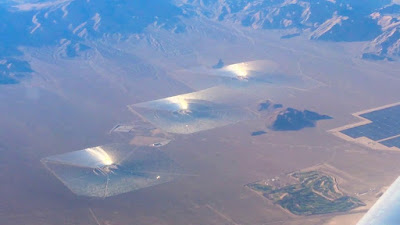Ivanpah Solar Power Facility, also known as the Ivanpah Solar Electric Generating System (ISEGS), is a concentrated solar thermal power plant located in the Mojave Desert of California, United States. It is one of the world's largest solar thermal power plants and is operated by BrightSource Energy, NRG Energy, and Google.
The Ivanpah Solar Power Facility, located in the Mojave Desert of California, off the i15 freeway on your way to Las Vegas, has a gross capacity of 392 megawatts (MW). This means that under ideal operating conditions, the facility is capable of generating up to 392 MW of electricity. The facility utilizes concentrated solar power (CSP) technology, specifically the power tower configuration, to generate electricity from sunlight. It is one of the world's largest solar thermal power plants and contributes to California's renewable energy goals.
What is the economics of the Ivanpah solar power plant?
The Ivanpah Solar Power Facility has faced some economic challenges since its construction. Here are some key aspects of its economics:
Cost of Construction: The construction cost of the Ivanpah Solar Power Facility was approximately $2.2 billion. The project received financial support from various entities, including private investors, the U.S. Department of Energy, and a federal investment tax credit for renewable energy projects.
- Operations and Maintenance Costs: Like any power generation facility, the Ivanpah plant incurs ongoing operations and maintenance costs. These costs include expenses related to labor, equipment maintenance, cleaning and maintenance of the mirrors, and other operational requirements.
- Power Purchase Agreements: The facility sells its generated electricity under long-term power purchase agreements (PPAs) with utility companies, including Southern California Edison and Pacific Gas & Electric. The terms of these PPAs and the rates at which electricity is sold may impact the financial performance of the facility.
- Revenue Generation: The revenue generated by the Ivanpah Solar Power Facility comes from the sale of electricity to the utilities under the PPAs. The revenue depends on the amount of electricity generated and the agreed-upon pricing structure in the contracts.
- Operational Challenges: The facility has faced operational challenges, including lower-than-expected electricity generation in its early years. Factors such as weather conditions, maintenance issues, and operational adjustments have affected its output and, subsequently, its revenue generation.
It's worth noting that specific financial details, including revenue, costs, and profitability, of the Ivanpah Solar Power Facility are not publicly available due to commercial confidentiality. However, it's important to recognize that solar power projects, especially innovative ones like Ivanpah, often face initial financial challenges but can provide long-term benefits such as reducing greenhouse gas emissions, diversifying the energy mix, and contributing to the renewable energy transition.
Key features of the Ivanpah Solar Power Facility include:
- Technology: The facility utilizes concentrated solar power (CSP) technology, specifically the "power tower" configuration. It consists of three solar thermal power towers surrounded by fields of mirrors called heliostats. These heliostats track the movement of the sun and reflect sunlight onto the power towers, where it is used to heat water and produce steam to generate electricity.
- Capacity: The Ivanpah Solar Power Facility has a gross capacity of 392 megawatts (MW). It was designed to provide enough electricity to power approximately 140,000 homes.
- Energy Generation: The facility generates electricity through a solar thermal process. The concentrated sunlight heats water in the receivers atop the towers, creating high-temperature steam. The steam drives turbines connected to generators, producing electricity.
- Environmental Benefits: The Ivanpah Solar Power Facility helps reduce greenhouse gas emissions by displacing conventional fossil fuel-based electricity generation. It also contributes to California's renewable energy goals and helps diversify the state's energy mix.
- Operation and Challenges: The facility commenced commercial operation in 2014. However, it has faced some operational and environmental challenges, including issues related to bird mortality due to the intense heat generated by the solar flux. The facility has implemented measures to mitigate these concerns, such as radar-based avian monitoring systems and other bird diversion techniques.
The Ivanpah Solar Power Facility serves as an example of concentrated solar power technology and demonstrates the potential of large-scale solar thermal power generation. It showcases the innovative use of mirrors and power tower technology to harness the sun's energy for electricity production.
How much money does the Ivanpah solar farm generate?
Specific financial information regarding the revenue generated by the Ivanpah Solar Power Facility is not publicly available. The facility operates under power purchase agreements (PPAs) with utility companies, which outline the pricing and terms of electricity sales. The revenue generated by the facility would depend on factors such as the agreed-upon rate per kilowatt-hour of electricity, the amount of electricity generated, and any contractual arrangements in place.
It's important to note that the facility has faced some operational challenges and lower-than-expected electricity generation in its early years, which may have impacted its revenue generation. However, the exact financial details and revenue figures for the Ivanpah Solar Power Facility are not publicly disclosed due to commercial confidentiality.
Overall, while the Ivanpah Solar Power Facility has faced economic challenges, it contributes to California's renewable energy goals, reduces greenhouse gas emissions, and provides valuable insights into large-scale concentrated solar power generation.

